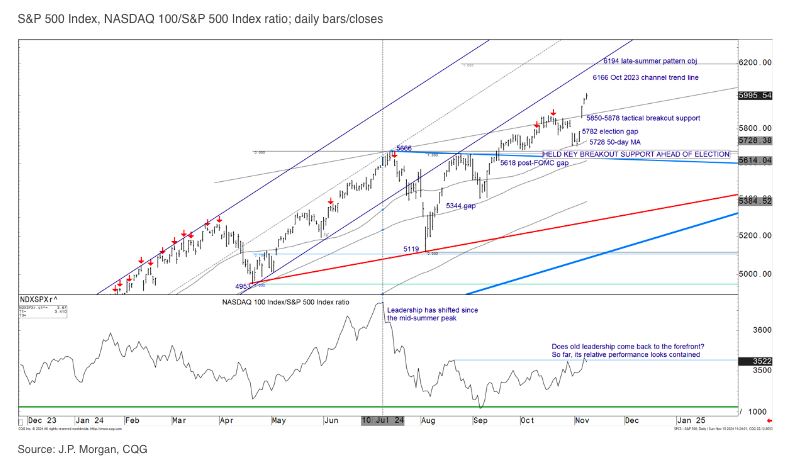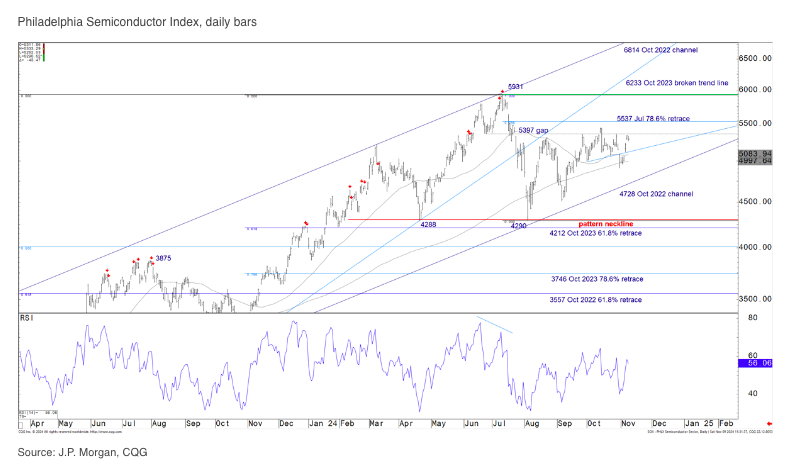While the S&P 500 Index continues its post-election surge, breaking through key resistance levels, the NASDAQ 100 is struggling to keep up.
This catch-up is prompting JPMorgan analyst Jason Hunter to ask: Is this a shift in market leadership or a temporary pause for the tech-heavy index?

After the S&P 500 re-accelerated through April’s channel resistance and the 5850-5878 highs post-election, the index remains firmly bullish, with key support holding in the 5600s. The next resistance levels are now pegged at 6166 and 6194. Meanwhile, the NASDAQ 100 has faced a roadblock, unable to surpass its August rebound high.
Hunter highlights that despite a broad market rally, the NASDAQ has underperformed, suggesting a potential leadership shift away from tech.
This divergence between the two indices is critical. If the NASDAQ 100 fails to break through its recent range, it would further support the idea that a regime change is in the cards — one where sectors outside of tech, like communication services, could be driving the market forward.
Read Also: iShares Semiconductor ETF (SOXX) Approaches Death Cross Despite Recent Gains: Should Investors Worry?
Interestingly, while the NASDAQ 100 as a whole struggles, the Communication Services sector has been leading the charge in the index’s breakout. Good news for investors in the iShares U.S. Telecommunications ETF IYZ and the SPDR S&P Telecom ETF XTL
Tech and semiconductor stocks have lagged, clustered just below resistance. Relevant for investors in the Vanguard Information Technology ETF VGT, the Technology Select Sector SPDR Fund XLK, the Invesco QQQ Trust Series I QQQ and the Invesco NASDAQ 100 ETF QQQM.
Hunter’s outlook suggests that in the coming weeks these hardware-oriented stocks may get “dragged higher” if the broader market rally continues. The question remains: Will they catch up, or will they continue to underperform as the rally unfolds?
Semiconductors, once at the heart of tech’s dominance, have been particularly sluggish. The Philadelphia Semiconductor Index (SOX) has faced stiff resistance at the 5397 July peak and the 5537 78.6% retracement level.

While it has managed to hold above the 4997 200-day moving average, Hunter is closely watching whether these resistance levels will break.
If the semiconductor sector can’t clear this hurdle, it would signal a continuation of the underperformance that has characterized the group since mid-summer.
On the other hand, if bullish momentum drags semiconductors through these barriers, it could fuel a catch-up rally in tech stocks, reversing the trend of broad market leadership shifting to other sectors.
Investors in the VanEck Semiconductor ETF SMH, the iShares Semiconductor ETF SOXX and the Direxion Daily Semiconductor Bull 3x Shares SOXL should remain wary of their holdings.
Despite these challenges, Hunter remains optimistic that the post-election bullish momentum could eventually carry tech stocks, particularly semiconductors, back into the leadership role they held for much of the 2022-2024 rally.
But if semiconductors continue to falter, and the broader market continues to rally without them, it could confirm that the days of tech dominance are coming to an end — at least for the near term.
For now, Hunter is watching for any breakouts in the tech sector, especially in semiconductors, to see if they can reclaim their former leadership position.
The key levels to watch are the 5397 July gap for the SOX Index and the 21433-22306 range for the NASDAQ 100.
Read Next:
This image was created using artificial intelligence MidJourney.
Market News and Data brought to you by Benzinga APIs

